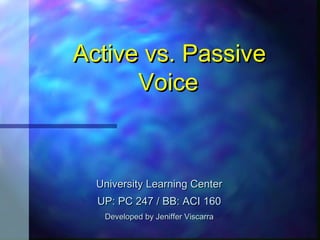
Active vs. passive voice
- 1. Active vs. Passive Voice University Learning Center UP: PC 247 / BB: ACI 160 Developed by Jeniffer Viscarra
- 2. Why should writers think about their verbs? “Verbs are the most important of all your tools. They push the sentence forward and give it momentum. Active verbs push hard; passive verbs tug fitfully.” -- William Zinsser, On Writing Well
- 3. What is Active Voice? In the Active voice, the subject performs the action. For example: Joseph draws a picture. Joseph is the subject and he is doing something (drawing).
- 4. What is passive voice? In passive voice the subject is acted upon. For example: The picture was drawn by Joseph. In this case, the drawing is the subject and it is being acted upon by Joseph.
- 5. When to use passive voice Use passive voice when you do not wish to emphasize the subject of the sentence. Example: Smoking is prohibited. (passive) The management prohibits smoking. (active) The passive sentence takes attention away from management, so they do not have to be in the role of the “bad guys.”
- 6. Passive Voice (con’d) Also use passive voice when you wish to emphasize what happened and the person or thing acting is unknown or unimportant. Example Poisonous gases were found in six factories. The use of passive emphasizes the finding of gases, not who found them. Note: Because passive voice often leads to awkward or wordy constructions, use passive voice sparingly and with good reason.
- 7. When to use active voice Use active voice unless you are required or have very specific reasons for doing otherwise. Active voice generally leads to more concise writing. It clarifies who is performing the action. Remember: Staying active is a healthy practice, especially in your writing!
- 8. How to avoid passive voice Many English verbs have been changed into useful nouns with the use of a suffix. Announce – announcement Propose - proposal Depart – departure Meet – meeting For active voice sentences use the verb instead of the noun form of these kinds of words.
- 9. Rewrite the following sentences by changing nouns to verbs. The two scientists could not arrive at a conclusion on anything. They held discussions on several topics. However, neither could put forth a proposal for a plan. They only made a translation of previous studies.
- 10. Possible Answers The two scientists could not conclude anything. They discussed several topics. However, neither proposed a plan. They only translated previous studies.
- 11. Changing From Passive to Active Voice Another way of preserving active voice is by placing the noun/s doing the action before the verb. Try it! The seeds were scattered by Jessica. A healthy harvest is expected by Jessica and her father.
- 12. Answers Jessica scattered the seeds. Jessica and her father expected a healthy harvest.
- 13. Avoid forms of the verb to be All passives consist of a form of the verb to be (am, is, are, was, were, being, been) plus a past participle. Example: The boy was impressed by Ms. Jones. A past participle is the ed form of regular verbs for irregular verbs: en, n, t) and can fill the empty slot in this sentence: “I had _______ it.”
- 14. Revise by avoiding to be verbs Houses were destroyed by the storm. The cake was eaten by me. Inexpensive ways for people to have fun are provided by parks. Oxygen was discovered in 1774 by Joseph Priestley. A kitten was chosen by the family to have as a pet.
- 15. Possible Answers The storm destroyed houses I ate the cake. Parks provide inexpensive fun. Joseph Priestley discovered oxygen in 1774. The family chose a kitten as a pet.
- 16. So What? Although both constructions are grammatically correct, the active voice is usually more effective in academic and business writing because it is simpler and more direct. The passive construction is effective only when the doer of the action is unknown or irrelevant. Examples The cruise liner was hijacked. The ball was hit. The town was quarantined. © UWF Writing Lab 16
- 17. Summary Use active voice unless specified otherwise. Make sure the subject is acting and not being acted upon. Use the verb form of words with suffixes Place subjects in front of the action they perform (this often eliminates to be verbs) Avoid to be forms of verbs
- 18. Works consulted Ebest, Sally Barr and Charles T. Brusaw. Writing from A to Z. Mountain View: Mayfield Publishing, 2000. Keen, Michael and Katherine H. Adams. Easy Access. Boston: McGraw Hill, 2002. Troyka, Lynn Quitman. Quick Access. Upper Saddle River, NJ: Prentice Hall, 2001.